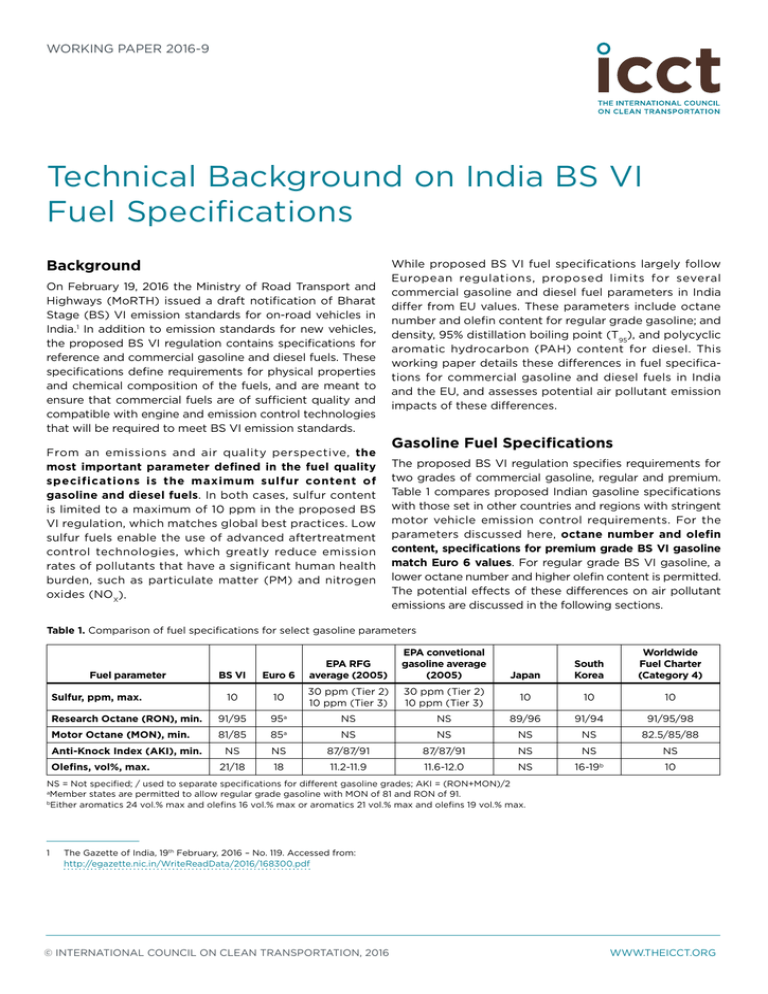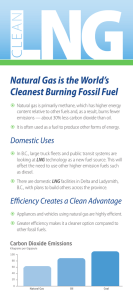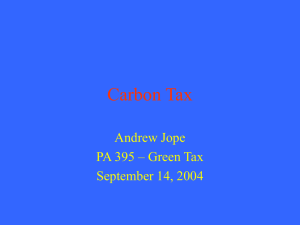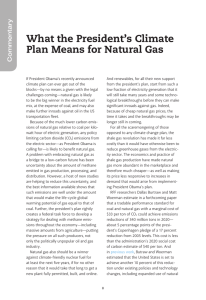Technical Background on India BS VI Fuel Specifications
advertisement

WORKING PAPER 2016-9 Technical Background on India BS VI Fuel Specifications Background On February 19, 2016 the Ministry of Road Transport and Highways (MoRTH) issued a draft notification of Bharat Stage (BS) VI emission standards for on-road vehicles in India.1 In addition to emission standards for new vehicles, the proposed BS VI regulation contains specifications for reference and commercial gasoline and diesel fuels. These specifications define requirements for physical properties and chemical composition of the fuels, and are meant to ensure that commercial fuels are of sufficient quality and compatible with engine and emission control technologies that will be required to meet BS VI emission standards. From an emissions and air quality perspective, the most important parameter defined in the fuel quality specifications is the maximum sulfur content of gasoline and diesel fuels. In both cases, sulfur content is limited to a maximum of 10 ppm in the proposed BS VI regulation, which matches global best practices. Low sulfur fuels enable the use of advanced aftertreatment control technologies, which greatly reduce emission rates of pollutants that have a significant human health burden, such as particulate matter (PM) and nitrogen oxides (NOX). While proposed BS VI fuel specifications largely follow European regulations, proposed limits for several commercial gasoline and diesel fuel parameters in India differ from EU values. These parameters include octane number and olefin content for regular grade gasoline; and density, 95% distillation boiling point (T95), and polycyclic aromatic hydrocarbon (PAH) content for diesel. This working paper details these differences in fuel specifications for commercial gasoline and diesel fuels in India and the EU, and assesses potential air pollutant emission impacts of these differences. Gasoline Fuel Specifications The proposed BS VI regulation specifies requirements for two grades of commercial gasoline, regular and premium. Table 1 compares proposed Indian gasoline specifications with those set in other countries and regions with stringent motor vehicle emission control requirements. For the parameters discussed here, octane number and olefin content, specifications for premium grade BS VI gasoline match Euro 6 values. For regular grade BS VI gasoline, a lower octane number and higher olefin content is permitted. The potential effects of these differences on air pollutant emissions are discussed in the following sections. Table 1. Comparison of fuel specifications for select gasoline parameters Fuel parameter EPA RFG average (2005) EPA convetional gasoline average (2005) Japan South Korea Worldwide Fuel Charter (Category 4) BS VI Euro 6 10 10 30 ppm (Tier 2) 10 ppm (Tier 3) 30 ppm (Tier 2) 10 ppm (Tier 3) 10 10 10 Research Octane (RON), min. 91/95 95a NS NS 89/96 91/94 91/95/98 Motor Octane (MON), min. 81/85 85 NS NS NS NS 82.5/85/88 NS NS 87/87/91 87/87/91 NS NS 21/18 18 11.2-11.9 11.6-12.0 NS 16-19 Sulfur, ppm, max. Anti-Knock Index (AKI), min. Olefins, vol%, max. a NS b 10 NS = Not specified; / used to separate specifications for different gasoline grades; AKI = (RON+MON)/2 a Member states are permitted to allow regular grade gasoline with MON of 81 and RON of 91. b Either aromatics 24 vol.% max and olefins 16 vol.% max or aromatics 21 vol.% max and olefins 19 vol.% max. 1 The Gazette of India, 19th February, 2016 – No. 119. Accessed from: http://egazette.nic.in/WriteReadData/2016/168300.pdf © INTERNATIONAL COUNCIL ON CLEAN TRANSPORTATION, 2016 WWW.THEICCT.ORG TECHNICAL BACKGROUND ON INDIA BS VI FUEL SPECIFICATIONS OCTANE NUMBER The octane number of gasoline provides a measure of the fuel’s ability to resist auto-ignition, which can cause engine knock and engine damage. The octane number is determined from laboratory testing and, depending on the test method used, expressed as a Research Octane Number (RON) or Motor Octane Number (MON). In some regions, octane rating is expressed using an anti-knock index (AKI), which is equal to the average of the RON and MON of the fuel. In general, octane number is more important to engine efficiency than air pollutant emissions. Higher-octane gasoline allows for higher compression ratios and engines can be designed and optimized for thermal efficiency. However, researchers have shown that fuel RON and changes in fuel composition associated with RON do not have a significant effect on regulated pollutant emissions from gasoline engines.2 This is in part due to the fact that engines are designed and calibrated to operate on fuel of a specified octane rating. As shown in Table 1, RON and MON specifications for regular grade BS VI gasoline (91 and 81) are lower than for Euro 6 gasoline (95 and 85). While these differences may have an impact on the fuel economy of the Indian fleet, they are not expected to impact air pollutant emissions. As evidenced by the United States, it is possible to have low emitting vehicles fueled by gasoline with octane ratings similar to those proposed for Indian BS VI regular grade gasoline. The AKI calculated from RON and MON specifications for regular grade BS VI gasoline is 86. This is very close to the AKI specified for regular grade gasoline in the United States, 87. Furthermore, both Japan and South Korea, where emission standards equivalent to Euro 6 have been adopted, have RON specifications for regular grade gasoline at or below the level set in the proposed BS VI standards. This means that, with respect to octane number, India will have similar requirements to other countries that have adopted world-class emission standards. In India, ethanol is blended with gasoline blendstocks to produce a final commercial product. The current ethanol content of commercial gasoline in India is about 5% by volume. In coming years, ethanol content is expected to increase to nearly 10% by volume. Because ethanol has a higher octane number than gasoline, it serves to enhance octane rating when mixed with gasoline. Anderson et al. investigated the relationship between ethanol content and octane number and developed a linear blending model to estimate the octane number of gasoline-ethanol 2 Esterhuyse, N.J. and A.D.B. Yates, A Study to Assess the Effect of Octane on Vehicle Emissions, 2002, SAE International, 2002-01-1664. 2 INTERNATIONAL COUNCIL ON CLEAN TRANSPORTATION mixtures.3 Using this model, blending 91 RON gasoline with 5% and 10% ethanol by volume would result in a blend with final RON of approximately 94 and 96 respectively. Similarly, blending 81 MON gasoline with 5% and 10% ethanol is estimated to produce a blend with a MON rating of 83 and 85 respectively. OLEFIN CONTENT Olefins are a class of hydrocarbon compounds characterized by the presence of at least one carbon-carbon double bond. The presence of this double bond makes olefins more reactive than other gasoline components such as paraffinic or aromatic compounds. This reactivity has several implications for combustion dynamics and air pollutant emissions. Generally, increased olefin content improves combustion efficiency, which may lower hydrocarbon (HC) emissions and increase NO X emissions. Increased olefin content may also result in increased emissions of the air toxic 1,3-butadiene, which is a product of the incomplete combustion of olefin precursors. 4 Because of their reactivity, olefins also tend to have higher ozone formation potentials than other hydrocarbon components in gasoline fuels. Hajbabaei et al.,5 found that increasing olefin content from 3% to 15% resulted in no significant change in emissions of primary regulated pollutants NOx, HC, carbon monoxide (CO), and of the air toxics benzene, formaldehyde, and acetaldehyde. The authors did measure a 26% increase in 1,3-butadiene emissions with the increase in fuel olefin content. A major conclusion of the study is that emissions from modern vehicles incorporating advanced combustion control and exhaust aftertreatment systems tend to be less sensitive to fuel olefin content than older technology vehicles. Olefin content is limited to 21% in the BS VI specification for regular grade gasoline. This is slightly greater than the maximum of 18% specified for Euro 6 gasoline. As documented above, this difference is not expected to significantly impact emissions of the regulated pollutants NOx, HC, and CO. The higher permitted olefin content may increase emissions of 1,3-butadiene, though analysis using the EPA Complex Model indicates increasing olefin content from 18% to 21% yields an increase in 1,3-butadiene 3 Anderson, J. E., et al. Octane Numbers of Ethanol-Gasoline Blends: Measurements and Novel Estimation Method from Molar Composition, 2012, SAE International, 2012-01-1274, doi:10.4271/2012-01-1274. 4 Hochhauser, A.M., Review of Prior Studies of Fuel Effects on Vehicle Emissions. SAE Int. J. Fuels Lubr., 2009. 2(1): p. 541-567. 5 Hajbabaei, M., Karavalakis, G., Miller, J. W., Villela, M., Xu, K. H., & Durbin, T. D. (2013). Impact of olefin content on criteria and toxic emissions from modern gasoline vehicles. Fuel, 107, 671–679. http:// doi.org/10.1016/j.fuel.2012.12.031 WORKING PAPER 2016-9 TECHNICAL BACKGROUND ON INDIA BS VI FUEL SPECIFICATIONS Table 2. Comparison of fuel specifications for select diesel parameters CARB designated equivalent limit Worldwide Fuel Charter (Category 4) BS VI Euro VI EPA coventional diesel Japan South Korea Sulfur, ppm, max. 10 10 15 15 10 10 10 Cetane Number (CN), min 51 51 Cetane index ≥ 40 or aromatics ≤ 35% 53 45 52a 55 820-860 845 (max) NS NS NS 815-835 820-840 370 360 NS NS 360b 360b 340 Polycyclic aromatic hydrocarbons (PAH), mass %, max. 11 8 NS 3.5 NS 5 2 Flash Point, Abel, °C, min. 35 55 NS NS 45 40 55 Fuel parameter Density @ 15°C, kg/m3 95% Distillation Boiling Point (T95), °C, max. NS = Not specified 48 from November 15 to February 18 Maximum 90% distillation boiling point (T90) specified in Japanese and South Korean standards a b emissions of only ~10%. 6 In general, olefin content is limited to a lower level in the United States relative to Europe. This is partly due to the effects of olefins on 1,3butadiene emissions and ozone formation potential, and is not linked to emissions of regulated pollutants such NOx, HC, or CO. Diesel Fuel Specifications Diesel fuel parameters for which BS VI specifications differ from Euro VI specifications include density, 95% distillation boiling point, and PAH content. Table 2 compares proposed Indian diesel specifications with those set in other countries and regions with stringent motor vehicle emission control requirements. The potential impacts of these deviations on air pollutant emissions are discussed in the following sections. DENSITY Density is a physical property of diesel fuel and closely related to both the fuel cetane number and aromatic content. As fuel injection is controlled volumetrically in diesel engines, fuel density influences the volume of fuel needed to maintain a constant power output. As density decreases, a greater amount of fuel is required to be metered through fuel injector orifices in a given amount of time. In regards to the effects of density on air pollutant emissions from diesel engines, a review by Lee et al. found reducing density tended to increase HC emissions, had small effects on CO and NOX emissions, and had no effect on PM emissions from heavy-duty diesel engines.7 A similar, more recent, review found reducing density tended to reduce CO, HC, and PM emissions from light-duty diesel engines and NOX emissions from heavy-duty diesel engines.8 In both cases, the authors note that advances in diesel engine design, such as higher injection pressure and electronic control of injection timing and rate, and the application of aftertreatment control technologies have both helped to reduce or eliminate the effects of fuel density on exhaust emissions. 95% DISTILLATION BOILING POINT (T95) The 95% distillation boiling point represents the temperature at which 95 percent of a particular diesel fuel distills in a standardized distillation test, and is used to characterize the back-end volatility of the fuel.9 Manufacturing diesel fuel to a lower distillation end point has the effect of excluding higher boiling waxy components with higher melting points from the diesel fuel. Lowering the distillation end point will thus yield lighter diesel fuel. A lower distillation end point also reduces fuel foaming, which reduces the need for antifoaming additives.10 A higher distillation point will result in a greater heavy fraction, which has a greater energy density, but may also lead to deposit formation in the engine.11 Research programs have found back-end volatility to have a relatively small effect on the emissions performance of 7 8 9 6 US Environmental Protection Agency, Complex Model. Accessed from: https://www.epa.gov/fuels-registration-reporting-andcompliance-help/complex-model-used-analyze-rfg-and-anti-dumping WORKING PAPER 2016-9 10 11 Lee, R., Pedley, J., and C. Hobbs, Fuel Quality Impact on Heavy-Duty Diesel Engines: A Literature Review. SAE Technical Paper Series, 1998, 982649. Hochhauser, A.M., Review of Prior Studies of Fuel Effects on Vehicle Emissions. SAE Int. J. Fuels Lubr., 2009. 2(1): p. 541-567. The 90% distillation boiling point (T90) can also be used as a measure of back-end volatility, and is the specified parameter in some country’s fuel regulations (e.g. Japan and South Korea). Chevron, Diesel Fuels Technical Review, 2007. HEI Special Report 17, Traffic Related Air-Pollution, Chapter 2, Appendix B, Fuel Composition Changes Related To Emission Controls, 2010. INTERNATIONAL COUNCIL ON CLEAN TRANSPORTATION 3 TECHNICAL BACKGROUND ON INDIA BS VI FUEL SPECIFICATIONS diesel engines. For example, Lee et al. noted that while reducing T95 may lead to slight increases in HC and CO emissions from heavy-duty engines, the overall effect of variations in back-end volatility on emissions of regulated pollutants is very small.12 Hochhauser found that reducing back-end volatility had little to no effect on emission from light-duty diesel engines, and tended to decrease PM and increase HC and CO emissions from heavy-duty diesel engines.13 These effects on emissions are dependent on the composition of the back-end. For example, heavy alkane waxes would tend to have an emissions benefit relative to low cetane PAHs.14 The BS VI specification for T95 of commercial diesel fuel is a maximum of 370°C, which is slightly greater than the European specification of 360°C. Increasing T95­ from 360°C to 370°C may increase engine-out PM emissions marginally, though It should be noted that the fuel sulfur level has a much greater impact of vehicle emissions and the performance of aftertreatment systems. A small increase in T95 temperature from 3600C to 3700C will not hurt overall emission performance, provided the overall sulfur content of the fuel is at or below 10 ppm, and cetane number is maintained at 51. PAH CONTENT Polycyclic aromatic hydrocarbons are organic compounds containing two or more aromatic rings. If not completely oxidized in the combustion process, unburned fuel PAHs can be emitted in the gaseous and particulate phases and, in both cases, contribute to the toxicity of diesel exhaust. Unburned fuel PAHs can also serve as precursors to soot formation. In general, reducing PAH content of diesel fuels has been shown to reduce emissions of NOX and PM from diesel engines. The European Programme on Emissions, Fuels and Engine Technologies (EPEFE) found a decrease in diesel fuel PAH content from 8% to 1% reduced PM emissions from light and heavy-duty diesel engines by 5% and 4%, respectively. NOX emission reductions tended to be smaller than PM reductions.15 For both pollutants, these fuel effects on emissions should largely be eliminated with 12 Lee, R., Pedley, J., and C. Hobbs, Fuel Quality Impact on Heavy-Duty Diesel Engines: A Literature Review. SAE Technical Paper Series, 1998, 982649. 13 Hochhauser, A.M., Review of Prior Studies of Fuel Effects on Vehicle Emissions. SAE Int. J. Fuels Lubr., 2009. 2(1): p. 541-567. 14 Chevron, Diesel Fuels Technical Review, 2007. 15 Hochhauser, A.M., Review of Prior Studies of Fuel Effects on Vehicle Emissions. SAE Int. J. Fuels Lubr., 2009. 2(1): p. 541-567. 4 INTERNATIONAL COUNCIL ON CLEAN TRANSPORTATION the use of advanced engine technologies and aftertreatment control systems, such as diesel particulate filters, which will be needed for all BS VI diesel vehicles. The BS VI regulation specifies a maximum PAH content for commercial diesel fuel of 11%. The corresponding Euro VI PAH content limit is 8%. This difference is not expected to significantly influence emissions of regulated pollutants given the aforementioned advances in engine design and application of aftertreatment control systems. Since PAH emissions contribute to the toxicity of diesel exhaust, the direction of fuel regulatory policy in both India and Europe should be towards reducing PAH content of diesel fuel to levels more in line with those advocated for by the Worldwide Fuel Charter, which recommends a maximum PAH content of 2%.16 Summary A common insight for each of these fuel parameters is that the magnitude of fuel effects on emissions of regulated air pollutants has decreased as engine and aftertreatment control technologies have advanced in design and efficiency. Modern engines incorporating advanced combustion control and exhaust aftertreatment systems have largely reduced or eliminated the effects of small changes in these fuel parameters on emissions. These modern engine designs require low sulfur fuels to maintain robust emissions performance throughout their useful lifetimes. It is due to this fact that the single most important fuel parameter specified in the proposed BS VI regulation is the 10 ppm limit on sulfur content of gasoline and diesel fuels. Access to ultra-low sulfur fuels enables the introduction of modern, low-emitting BS VI vehicles that incorporate best available technologies for the control of air pollutant emissions. Relative to the exceedingly large emissions benefits that will result from the implementation of proposed BS VI emission standards in 2020, any change in air pollutant emissions resulting from differences between BS VI and Euro 6/VI fuel specifications is likely to be minimal. By 2023-2025 timeframe, India should try to match, or even improve upon, Euro 6/VI fuel specifications. However, current differences in fuel quality specifications should not delay the full implementation of BS VI emission standards in 2020. 16 Worldwide Fuel Charter, 5th edition, September 2013, Accessed from: http://www.acea.be/files/world_wide_fuel_charter_2013 WORKING PAPER 2016-9





